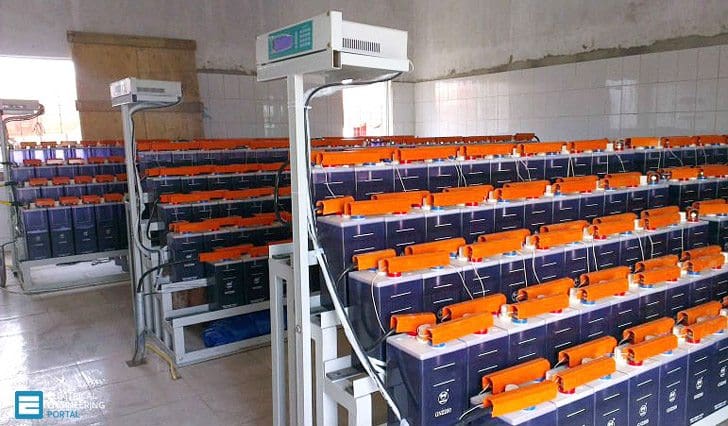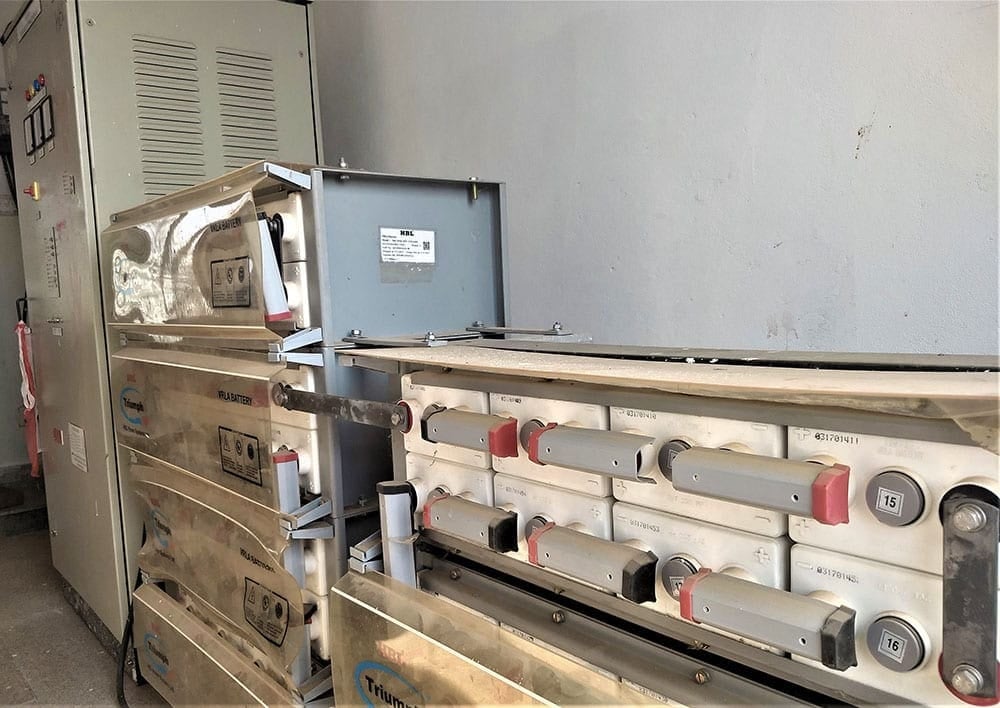Backup system reliability
Battery monitoring has become a very popular topic, and many companies have either purchased equipment or are in the process of evaluating these systems. This article discusses why monitoring is important, and what parameters must be monitored.

A brief explanation of battery failures is included to support the recommendations presented.
This technical article is essentially a guide for selecting the right monitor system capabilities required to achieve optimum backup system reliability.
Introduction
It is now exactly twenty years since the first battery monitor was introduced. In fact, our original patent has expired. The first monitor was primarily designed to reduce maintenance hours and replace inexperienced maintenance personnel.
Since those early days, a lot more has been learned about why and how batteries fail, and a whole new set of battery problems has arrived with the introduction of VRLA batteries.
Today, it has become obvious to users that battery performance cannot be taken for granted. The cost of failures makes the cost of monitoring seem insignificant, especially in large data center applications where even a momentary power glitch to the computers can equate to many millions of dollars in losses.
Why monitoring is necessary?
There are many arguments for monitoring, but the most obvious reasons are:
- Increased system reliability
- Cost savings from reduced maintenance hours, and optimized battery life that justifies initial investments
- Personnel safety
Increasing system reliability
Increasing system reliability by eliminating power outages is obviously a huge cost saving. Sometimes, spending money to save money is a tough argument to prove to company accountants, but when the cost of failure is compared to the cost of monitoring, it almost seems irresponsible not to consider it.
How can monitoring improve system reliability?
Monitoring improves system reliability by detecting battery problems at an early stage, before they can cause an abrupt system failure.
How are problems detected?
Problems are detected by measuring the internal resistance of each cell or module in the system. The resistance of a cell has been proven to be a reliable indicator of a battery’s state of health. The only other method for testing a battery’s condition is to perform a capacity test. No one can argue the effectiveness of a capacity test, but, unfortunately, because of its cost to perform, many users will not load test their batteries.
The chief advantage of a resistance test is that it can be performed automatically, without any test personnel present.
Cost savings
There are three ways that monitoring can provide cost savings that readily offset the initial cost of purchasing a monitor system: by reducing maintenance time, by optimizing battery life, and by reducing test costs.
Reducing maintenance time?
The time required to maintain the batteries in a typical small UPS battery cabinet, small telephone office, or power company substation, in accordance with IEEE standards, is at least 25 hours a year. Most of these hours can be saved by using a monitor, and the hours saved will pay for a top of the line battery monitor in two to four years.
Optimizing battery life
Battery life is greatly affected by ambient temperature, excessive cycling, and float voltage. A monitor that assists the user in taking corrective action against any out-of-tolerance condition can prevent premature aging of the batteries.
Many users only obtain 50% to 80% of the realistic life of their batteries.
Reducing test costs
Every new battery system must be acceptance tested with a capacity test to prove that it will be able to perform when needed. It is also prudent, especially in applications where financial or safety issues are involved, to perform periodic capacity tests to determine where the battery is in its projected life.
The cost to perform these tests is several thousand dollars per test and requires a lot of setup time. A permanently installed monitor that can log data during a scheduled or unscheduled discharge eliminates a substantial amount of these costs.
Safety
A permanently connected battery monitor reduces the need for maintenance personnel to directly contact the high voltages present in most battery systems. If the monitor identifies a problem, then the battery may have to be accessed by maintenance personnel. In the case of a problem, however, the battery will typically be disconnected from the load and the charger, thus reducing the exposure.
UPS systems that have batteries installed in a cabinet are especially hazardous to work with, since there is very little space to access the battery terminals for routine maintenance measurements. And, besides the personnel safety issues, there is also always the danger of someone accidentally creating a problem that shuts the system down.
What parameters MUST BE monitored?

Some battery parameters are monitored to verify the battery is being operated in an environment that guarantees optimum life, and some are monitored to track the state of health of the battery.
- Overall string voltage. To verify the charger has been set correctly and is operating properly.
- Cell voltages. To verify all cells are charging correctly.
- Ambient temperature. To verify the temperature environment is at or near optimum temperature for long life and maximum capacity.
- Internal cell resistance. To verify the state of health by identifying low capacity cells.
- Intercell resistance. To check the conduction path integrity and avoid possible fires and abrupt shutdowns.
- Load cycles. To check the number and depth of discharges. This information is used to project battery life and settle warranty issues. Other parameters that are useful in analyzing battery performance are:
- Load current. The current delivered by the battery during a discharge is used to calculate the capacity of the battery. It is also useful in parallel string applications to see how the strings share the load.
- Float current. The float current drawn by a battery can be useful in VRLA batteries to detect thermal runaway conditions.
Why batteries fail?
General
It should be noted that all lead acid batteries have a limited useful life. The normal failure mode that dictates the end of life of a well-maintained flooded battery is positive grid corrosion. The positive grids lose their mechanical strength and start to break apart. Sometimes before this happens, the grid structure has grown to a point where the paste or active material has lost a lot of contact with the grid.
Both problems lead to large increases in internal resistance that can easily be detected. In fact, it is the authors’ belief that, due to the predictable decay of flooded cells, internal cell resistance measurements can be used to predict end of life. The normal life of a good quality flooded battery is twenty years.
VRLA product today has only about a seven-year life span, and these cells do not live long enough to die of normal positive grid corrosion. The most common problem for their early demise has been a drying out or loss of water in the electrolyte.
There are also investigations that indicate that secondary reactions from internal recombination of hydrogen and oxygen gasses may be adversely affecting the polarization voltage of the negative plates and/or accelerating positive grid corrosion. Both problems lead to a loss of capacity.
Failure analysis

The following problems, most of which can be controlled by the user, are the most common causes of premature battery system failures:
Excessive cycling
The cycling capability of a lead calcium battery depends on the depth of discharge. For example, the battery is only capable of 50 deep cycles (the removal of more than 80% of energy), but can deliver 300 cycles for a 25% depth of discharge cycle.
A UPS battery which normally only delivers about 25% of its stored energy during its 15 minute rated reserve time can deliver 300 such cycles.
Post seal leakage
A leaky post seal allows acid to migrate up to the post/intercell connection area and cause a connection problem. Loose intercell connections. Improperly tightened intercell hardware means very high resistance connections.
Low float voltage
This causes sulfate crystals to form on the plate surfaces. Sulfate crystals that harden over a long period of time will not go back in solution when proper voltage is applied and, therefore, cause permanent loss of capacity. This problem shows up as an increase in cell resistance.
High float voltage
This causes excessive gassing of hydrogen and oxygen, and this leads to loss of water in flooded cells, and dryout and potential thermal runaway in VRLA cells. High float voltage also causes shedding of active material from the positive plates. All of these problems increase the internal resistance of the cell. Low temperature.
Battery capacity is diminished at low temperatures. (At 62°F, capacity is approximately 90%.) At low temperatures, a higher float voltage is required to maintain full charge. If the charger is not adjusted properly, cells may be undercharged, leading to the problems described under low voltage.
High temperature
This causes loss of battery life. (Life is cut in half if operated at greater than 92°F.) High temperature also increases float current, which results in loss of water in flooded cells, and dryout and thermal runaway in VRLA cells. These problems lead to increase in cell resistance. Discharge without recharge. A fully discharged or nearly fully discharged cell will be damaged and possibly ruined if not recharged within 24 to 48 hours.
Overdischarge
This causes abnormal expansion of plates, which can lead to permanent damage and recharge problems. This can happen in lightly loaded UPS systems that experience an extended power outage.
Electrochemical resistance increase
An increase due to problems in the paste or electrolyte. This failure causes the cell to “run out of fuel” and become incapable of delivering rated capacity.
Metallic resistance increase
The more serious and dangerous of the two resistance problems. A high metallic resistance means a problem in the conduction path, which can lead to a catastrophic failure, such as an explosion or a total loss of the current carrying path.
The metallic resistance problems can lead to abrupt failures, causing potential harm to equipment and personnel, not to mention loss of power.
Failure analysis summary
It should be obvious from the above discussion that almost all battery problems can be detected by an increase in the internal resistance of a cell. It should also be noted that intercell connection problems can cause fires and abrupt interruptions. That makes resistance measurements mandatory for applications that cannot tolerate a loss
of power.
The only battery test that can provide better information on the state of health of a system is a true capacity test. Since the internal resistance of a cell can be used to predict its performance, it is important to know what the resistance value (baseline value) of a known 100% capacity cell is, and then periodically compare the resistance value of the cell to this baseline value.
Battery system maintenance reqirements
Many battery users do not understand what is required to maintain a reliable battery system. They therefore:
- do nothing at all while waiting for the system to fail;
- hire a maintenance service and trust that they know what to do;
- connect the cheapest monitor they can find and rely on it to alarm in time; or, hopefully,
- study the recommendations made by industry experts, such as the IEEE Standards Coordinating Committee SCC-29.
The following sections discuss, very briefly, what the IEEE Standards recommend in the way of maintenance and testing for both vented lead acid style battery systems and valve regulated lead acid battery systems. By comparing the requirements of the standards with the functions that can be automatically performed with a monitor, it will be easy to conclude that a monitor can save maintenance and test hours.
Some maintenance inspections, such as visual, cannot be ignored and must be performed at least once a year. A permanently connected monitor also obviously raises the battery system reliability by a significant factor, since it is on duty 24 hours of every day of the year.











Hi guys, how to disconnect battery bank 110VDC how to start ? It’s 9pcs batteries 12V. Should I disconnect battery breaker first, then divide battery bank on half? Tank you in advance.
Hi, what float and absorption voltage should be set in charge controller for Bosch T5080 225Ah battery ? Can this type of battery be charged with these parameters (number 9) (NiCad 2) 14.5 float volt and 16 volt absorption ? Current Charge controller Victron Energy bluesolar mppt 12v/24v|40A
i need a preservation procedure/ checksheet for batteries.
Hi Edvard.
Every day this topic becomes more interesting.
I am involved in Solar PV Off Grid Solar Systems with Lead Acid battery Storage as a system designer and installer.
I have never been overly impressed by the traditional charge controller arrangements around so we prefer to use our own charging strategy via direct DC to DC coupling, with some basic controls. It works well but I want to take it to the next level which will incorporate “Dynamic Optimised Charging Algorithms” which will be calculated in real time via circuit performance itself and readjust seamlessly and instantly via solid state controls.
I believe that there can be some real efficiencies gained by simply taking advantage of a direct DC to DC Solar to Battery Bank coupling that will take care of both Load Supply and Charging [via of course some dynamic control technology]. After all the battery charging process is simply a component of load. I appreciate that there needs to be smart controls involved in this but they can be vastly improved on in solid state rather than this round about and never precise charge controller way.
In order to take total control of the process though in solid state circuitry incorporating gated SSR’s for example, I am thinking more about Battery Internal Resistance as one critical parameter that I want to know and use as a control variable in our logic.
The problem I have is this; how can I measure [or calculate] the Internal Resistance of a battery bank on the fly. In other words dynamically.
You mentioned in this article:
How are problems detected?
Problems are detected by measuring the internal resistance of each cell or module in the system. The resistance of a cell has been proven to be a reliable indicator of a battery’s state of health. The only other method for testing a battery’s condition is to perform a capacity test. No one can argue the effectiveness of a capacity test, but, unfortunately, because of its cost to perform, many users will not load test their batteries.
The chief advantage of a resistance test is that it can be performed automatically, without any test personnel present.
——————————–
You have me curious now Edvard – how can this IR test be accomplished and incorporated [in circuitry]?
I hope you can steer me in the right direction please Edvard.
Lawrence
I need to learn how to maintain sealed maintenance batteries with all ieee specifications. Can you guide me.
First, it would be best to contact some battery manufacturers and ask them to guide you to their recommended maintenance procedure.
Also, try visiting some of these sites:
– The IEEE Standards Association Stationary Batteries Committee
– VRLA Battery Maintenance
– IEEEE Std 450 Recommended Practice For Maintenance Testing And Replacement Of Vented Lead-Acid Batteries
Hope this will help in the beginning!
Many of battery users and companies don’t care for battery condition at all . They purchase batteries and necessary equipment, install them and after few years they wake up when system fails. System reliability must be monitored from many aspects, and one of them, not less important then others is battery monitoring and maintenance.